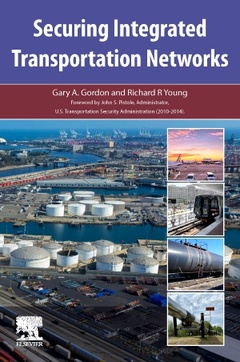Securing Integrated Transportation Networks
Auteurs : Gordon Gary A., Young Richard R.

Securing Integrated Transportation Networks provides a comprehensive look at multimodal transportation security?its dynamics, evolving threats, and technology advances that enhance operational security and related infrastructure protection and hardening, as well as the regulatory environment. As threats are evolving, so is the technology used in enhancing transportation security, operational procedures, and regulations. This book addresses this dynamic evolution of transportation security, serving as a primary reference for information on the range of activities and components involved in transportation security. It covers the myriad parts involved in the relationship between, and among, logistics, the supply chains and transportation entities, and more. In addition, it looks at operations, infrastructure, equipment, laws and regulations, policies and procedures, and risk focused on transportation safety and security by mode and transportation in general. Cooperation and partnering with and among the industry, to include transportation providers and government agencies, is the way forward to ensure that security is maintained and keeps pace with the evolving threat and regulatory landscape.
1. What is transportation security and why do we want to secure it?
2. Transportation security before and after 9/11
3. The regulatory environment and government agency roles 4. Who are the parties involved and what are their relationships
5. What are the components and economics of transportation security?
Section II – Exposure
6. Nature of people and the goods transported
7. Threats, vulnerabilities and risk
8. What is the difference between natural and manmade disasters
9. Assessing Risks
10. Cyber threats and risks
Section III – Transportation modes, interrelationships and supply chain resilience
11. Highway and motor carrier
12. Freight and passenger rail
13. Bus and rail transit
14. Maritime
15 – Aviation
16. Intermodal transportation
17. Pipeline
Section IV - What is being done about transportation security?
18. Regulatory compliance and partnered initiatives
19. Risk models and methods and industry best practices
20. Physical vs. operational security measures
21. Where do we go from here?
Richard Young is Distinguished Professor of Supply Chain Management at Pennsylvania State University. Previously he held corporate supply chain management positions and was as consultant for a wide range of transportation and industrial firms. He is on the editorial boards of several supply chain journals, a Fulbright German Research Scholar, and received the Distinguished Educator Award of the National Defense Transportation Association. His work has been published in Journal of Transportation Security, Transportation Journal, International Journal of Physical Distribution and Logistics Management, Journal of Supply Chain Management, International Journal of Logistics Management, and Journal of Emergency Management.
- Introduces readers to the characteristics of the motive power, freight or passage haulage units, physical infrastructure required, the operating environment itself and the information technology applicable to both operating and managing customer-provider relationships—all of which to foster safe, secure, effective, and efficient operations
- Includes discussion questions and case studies available for assignments and subsequent classroom discussion, whereby real-world scenarios serve to hone analytical abilities
- Discusses the risks and vulnerabilities that various supply chains and associated transportation modes may pose to the ability of a firm to maintain ongoing operations, helping them to analyze trade-offs and mitigate threats
Date de parution : 06-2024
Ouvrage de 245 p.
15x22.8 cm



